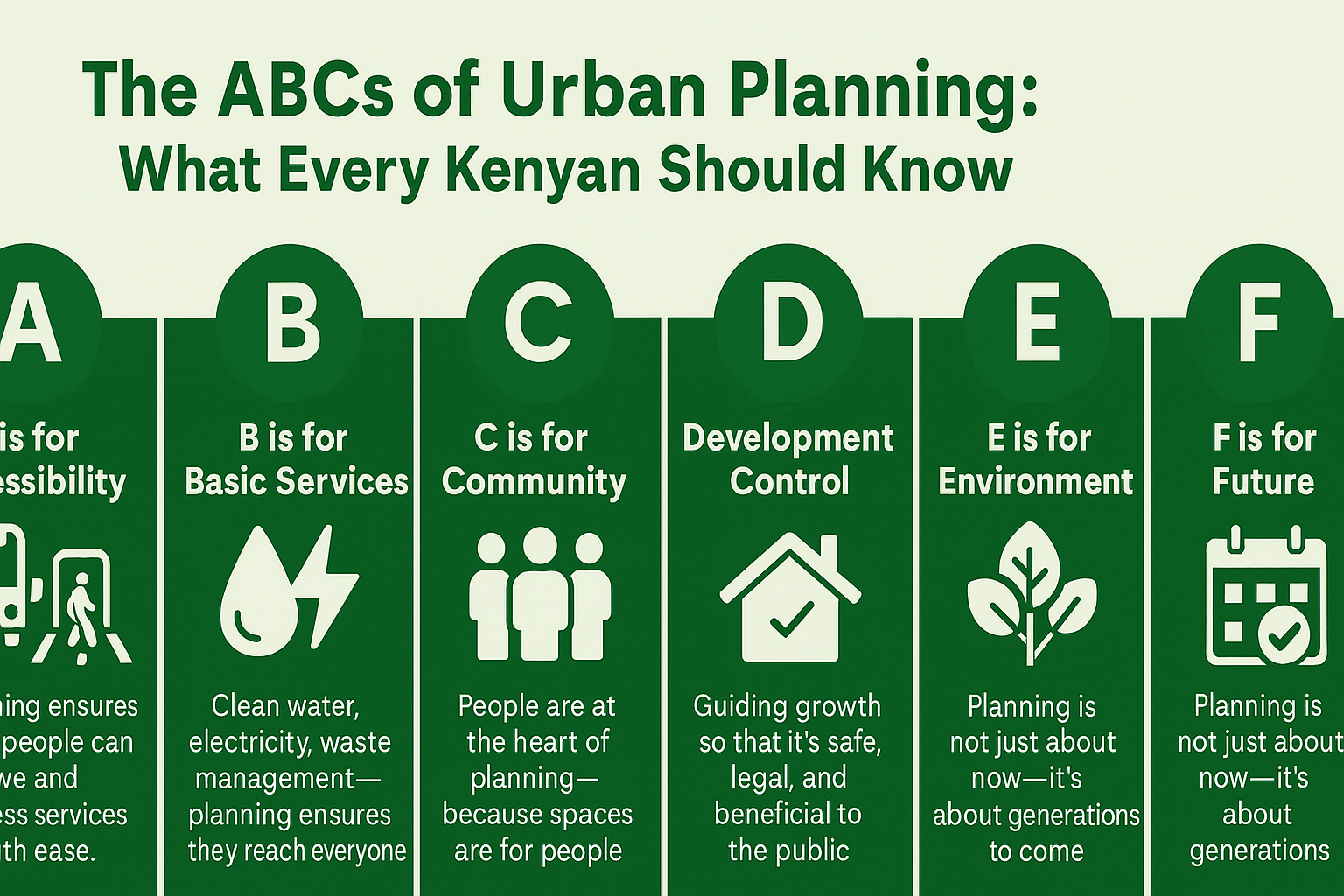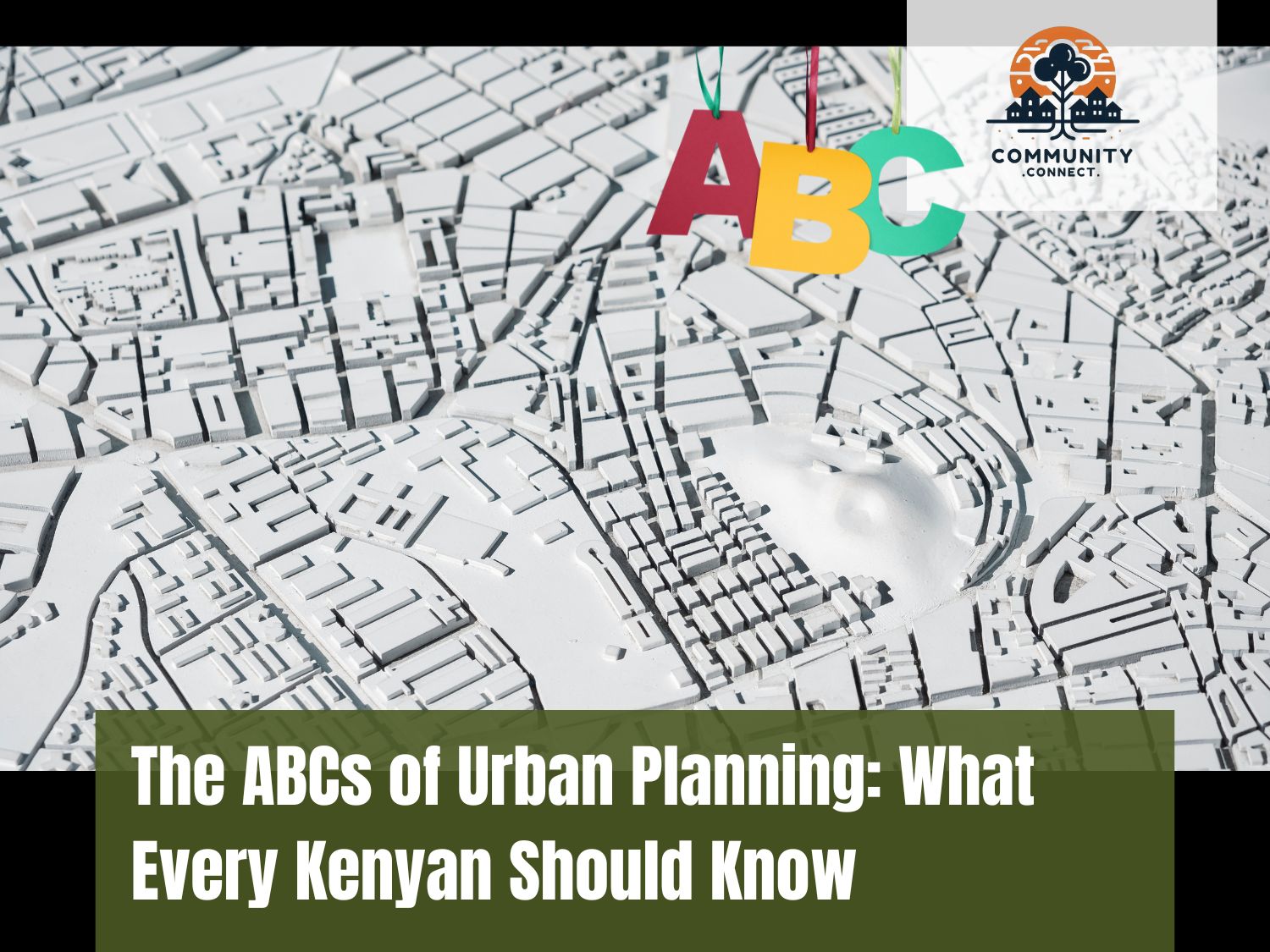Urban planning might sound like a technical profession reserved for engineers and architects, but the truth is—it affects all of us. Whether you’re navigating traffic in Nairobi, buying land in Kisumu, or attending a community baraza in Machakos, urban planning plays a silent yet powerful role in shaping your daily life.
This guide breaks down the basics of urban planning for every Kenyan to understand: what it is, why it matters, and how you can play a part.

A is for Accessibility
Planning ensures that people can move and access services with ease.
Accessibility means more than just roads. It includes pedestrian walkways, cycling lanes, ramps for persons with disabilities, and the distribution of services such as schools, clinics, and water points. A well-planned urban area ensures that people of all ages, backgrounds, and physical abilities can reach what they need without struggle.
Example in Kenya: In Nairobi’s Central Business District (CBD), street upgrades and pedestrian walkways on Aga Khan Walk and Kenyatta Avenue have improved walkability and reduced congestion.
B is for Basic Services
Clean water, electricity, waste management—planning ensures they reach everyone.
Urban planning helps local governments design systems that supply water, manage sewage, collect waste, and distribute energy efficiently. When these are poorly planned, communities experience flooding, garbage accumulation, or water shortages.
Reality Check: In many informal settlements like Kibera or Mukuru, lack of planning has resulted in unsafe housing and poor sanitation. Strategic planning is essential for upgrading such areas without displacement.
C is for Community
People are at the heart of planning—because spaces are for people.
Urban planning isn’t just about land use and zoning. It’s about building inclusive communities where people feel safe, connected, and engaged. Planners work with community leaders, elders, youth, women’s groups, and residents to ensure that development reflects local needs.
Public participation is a legal requirement under Kenya’s Physical and Land Use Planning Act (2019). This means citizens can—and should—have a voice in how their environment evolves.
D is for Development Control
Guiding growth so that it’s safe, legal, and beneficial to the public.
Development control means regulating how land is used and ensuring that buildings meet certain standards. This includes approving building plans, enforcing zoning regulations, and ensuring that new developments have parking, open space, and proper drainage.
Why it matters: Without development control, we see unplanned settlements, traffic chaos, and buildings collapsing due to poor construction.
E is for Environment
Planning protects our land, water, trees, and air.
A key part of urban planning is safeguarding the environment. This includes creating green spaces like parks, protecting wetlands and forests, and managing pollution. Environmental Impact Assessments (EIA) are used to ensure that new developments don’t harm ecosystems or public health.
Example: Karura Forest in Nairobi is a great case of an urban green space that enhances biodiversity, provides recreation, and reduces the urban heat island effect.
F is for Future
Planning is not just about now—it’s about generations to come.
Planners think long-term. They consider population growth, climate change, urban migration, and economic shifts. This helps ensure that cities remain functional, sustainable, and inclusive in the future.
Lack of planning today leads to disasters tomorrow—flooding, gridlock, and overcrowded slums are often the result of ignoring future needs.
How Urban Planning Happens in Kenya
Urban planning is guided by national and county-level frameworks, including:
- County Spatial Plans (CSPs) – long-term development frameworks for counties
- Local Physical and Land Use Development Plans (LPLUDP) – detailed plans for towns and neighborhoods
- Integrated Urban Development Plans (IUDPs) – for managing urban growth across functions
- Development Applications – submitted by landowners and developers for approval
All these are governed by the Physical and Land Use Planning Act, 2019 and overseen by county planning departments and the Physical Planners Registration Board (PPRB).
How You Can Get Involved
Urban planning affects where you live, how much rent you pay, how far you travel for work, and the safety of your streets. Here’s how you can participate:
- Attend public forums or barazas when plans are announced
- Review planning notices in newspapers or county websites
- Report illegal developments to local planning offices
- Ask questions before buying land—especially about zoning and infrastructure
- Join or follow community organizations focused on local development
Conclusion: Urban Planning Is Everyone’s Business
You don’t need a degree in urban studies to care about planning. Every Kenyan is a stakeholder—whether you’re a boda boda rider, a land buyer, a mama mboga, or a student.
The better we understand the ABCs of urban planning, the more we can push for towns and cities that are fair, functional, and future-ready. It’s time to move from being passive residents to active planners of our communities.

Leave a Reply